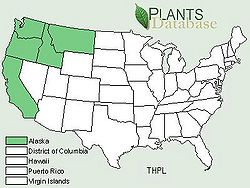Western redcedar
| Western Red-cedar |
|---|

|
| Scientific Classification |
|
| Binomial Name |
|
Thuja plicata |
| Habitat Range |
The Western Redcedar is a species of conifer tree mostly found in North America, which was given the scientific name Thuja plicata. It grows up to 60 meters high and can live to be 800 years old. The Quinault Lake Cedar is largest Western Redcedar known to man. Since this Gargantuan tree is so large, Amerindians used to carve out totem poles and canoes. It has been given the name "arborvitae," meaning the "Tree of Life." The Northwestern Pacific region of the United States climate suits the Western Redcedar best, since it can barely tolerate high temperatures. Unique features that make this tree stand out from others: droopy branches that flip up at the end, scale-like leaves, and a large trunk.
Anatomy
The Western Redcedar is a very large tree, growing up to 50-60 meters tall and the trunk grows to be 3-6 meters wide. The largest tree in the world is classified under this species. The foliage of the Western Red cedar is like that of a scale and is very flat as it droops from its host. The fruit of the tree grows near the end of the leaf and is around 15-20 millimeters long and 4-5 millimeters wide. The branches of the Western redcedar are very flexible, but still holds great strength. The bark is so strong, that it was used for fishing line and rope. The wood of this particular tree is very resistant to rotting and decaying away.
Reproduction
The seeds of a Western Redcedar start producing when the tree is at age 10-30 years old; depending on where the tree is located. The cones and fruit of the Western Redcedar are very small in size compared to most other trees. When the seeds have fully matured they will break of the parent tree and be dispersed by the wind. Germination occurs on the ground around 400 feet away from the parent tree. The best soil beds for the seedlings are burned surfaces and highly moist surfaces. The seedling survival rate is very low due to high temperatures in the soil, being covered by leaves, and more. Seedlings also grow best in mild shade. The Western Red-cedar uses vegetative reproduction. Three types of vegetative reproduction this tree uses are: layering, fallen branches starting to root, and rooting of the trunk off of other trees.
Ecology
The Western Redcedar mainly grows in the Northwest in the United States. It likes the climate of the Northwest best because of its mild summers and its wet and rainy winters. Thirty five to two hundred and sixty inches of annual precipitation is the best suited rainfall for the Redcedar. It especially likes moist ground and doesn't need very much sunlight, but a young Redcedar can't handle to much shade.
Uses
This tree has very many uses, since it is so resistant to decaying. Most of the uses of this tree have been used in construction, such as: posts, decking, shingles, siding, and basically everything else used in the construction of a house, because of its strength. The Native Americans even used this tree for things like: canoes, totem poles, houses, masks, helmets, armor, and many more items used in art and battle.
 Browse |
Related References
- WESTERN RED CEDARThuja Plicata
- Western Red CedarWestern Red Cedar
- Western Red Cedar Characteristicsby Hobby-Greenhouse
- Western ConifersPhoto Gallery of Western Conifers


